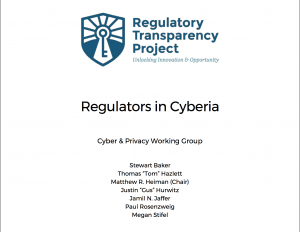A team from the Regulatory Transparency Project, including NSI Founder Jamil N. Jaffer and NSI Advisory Board members Stewart Baker and Paul Rosenzweig, recently authored a ground-breaking paper on cyber regulations. The paper highlights the unintended consequences that regulations can have on America’s most dynamic and fastest growing industry: the technology sector. This paper is the first of a series exploring differing viewpoints on regulatory matters. The paper is available here and more information about the Regulatory Transparency Project can be found here.
Key highlights from the paper include:
- What is the role of Federal regulation and standard setting in the technology sector?…Our conclusion is simple – regulation should be the [f]ederal tool of last resort.
- Over the past four decades or so, the technology sector has enjoyed rapid growth, with tremendous innovation across a wide range of markets, in significant part because of the relative lack of regulation.
- This is not to suggest that the technology industry, like others, could not benefit from incentives to promote beneficial behavior, nor that regulation may never be necessary[; t]o the contrary, there are a wide range of social outcomes that policy makers might want to encourage.
- [T]he best approach to obtaining potential benefits is typically with positive incentives (the “carrot”) rather than reaching instinctively for the regulatory “stick.”
- With parties given incentives to create solutions, imaginative new approaches can improve outcomes while costly “unintended consequences” are avoided.
- While the use of positive incentives may take longer to propagate through the economic system than the use of direct regulation, the reality is that positive incentives, particularly if deployed to a wide range of organizations…can have similar outcomes to direct regulation over the long run.
- The danger of regulatory overreach in the technology sector is particularly strong. Regulations are inherently rigid…This reality makes it hard to engage in rapid course correction when needs change, perhaps – as endemically occurs in this sector – because an established business model has been disrupted or an underlying technology displaced.
- Rules which had been perceived as necessary remain stuck in time, fixed in place long past their usefulness. There they become impediments rather than expedients.
- More often than not, regulators would be wise to follow the advice, “Don’t just do something, stand there.”
- With short-lived product cycles and waves of technological progress, heavy administrative processes will struggle to keep up. Regulators are not known for an innovative approach to seeking better, more efficient ways to regulate.
- In an environment where the market is dynamic, this paper concludes that the best answer is a “do no harm” approach to the use of regulatory tools…[employing] general standards whose meaning evolves as technologies change.
To read more, click here.

